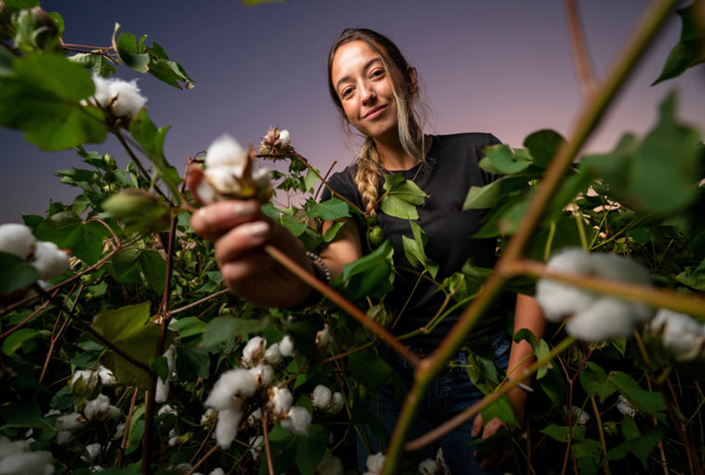Weed them and reap: Taking aim at cotton’s herbicide-resistant nemesis

Every female Palmer amaranth plant can produce more than 1 million seeds that may germinate and compete with a cotton crop.
One doctoral student is taking on these weeds, which rob farmers through herbicide costs, yield damage or quality losses. Palmer amaranth is highly adaptable, spreading all the way up to Minnesota and Canada, and is increasingly becoming resistant to more and more herbicides.
Sarah Kezar is determined to make sure fewer Palmer amaranth plants live and produce seed, thus helping producers reap greater economic benefits. She is currently at the Department of Soil and Crop Sciences in Texas A&M’s College of Agriculture and Life Sciences.
Kezar started her college life as an animal science major in Oklahoma. A series of professors and mentors who crossed her path guided her to the Texas A&M weed science program, headed by Muthukumar Bagavathiannan.
Bagavathiannan, a Texas A&M AgriLife Research weed scientist, leads a rigorous research group that is gaining national and international recognition in weed science research.
“We submitted a six-page grant proposal in the next generation crops category,” Kezar said. “My study set out to determine how Palmer amaranth impacts cotton production; how we can help producers sustain the utility of existing herbicides by developing new weed management tactics; and how that will play into managing these resistant weeds in cotton and other systems.”
Many producers will see the Palmer amaranth escapes late in the season in their fields and think “those few plants don’t matter” and let it go because the conventional weed management time window has passed, Kezar said.
“Even if we let one female Palmer amaranth plant escape in-season control measures, she contributes to that seed bank,” Kezar said. “And next year, the farmer will have to deal with several hundreds of thousands of seeds. We can have a tremendous impact on that number by targeting those escapes in the late season.”
Kezar’s field study is looking at a multi-tactic approach to control late-season, or after layby, Palmer amaranth escapes in cotton.
“Can we spot spray with drones? Can we chop to cut off the seed head? Can we desiccate early to hit the Palmer amaranth plants before they go to seed? Can we use a gametocide and reduce the amount of pollen that can cross with the females, thus the number of seeds it contributes and the vigor of the seed that falls into the seed bank?”
Kezar said being a part of Bagavathiannan’s program has given her the ability to be curious, think outside the box and explore many options.
“I have a light box that includes red and far-red light bars to see if manipulating the red to far-red ratio can influence dormancy and germination of the seeds,” she said, explaining it is only one method they are exploring. “We know it’s going to take an integrated approach, but in the end, we also know the weed seed control methods we explore need to be applicable for producers.”
And finally, any approach must be economical to make it a viable tool for the producer.
“Again, one female Palmer amaranth, 1 million seeds,” Kezar said. “If you can make significantly fewer seed contributions, then you are inherently reducing the amount of potentially resistant seed that will directly compete with your crop the following year. If you do that year after year, you are going to greatly decrease the number of resistant weeds that are competing with your crop.”

